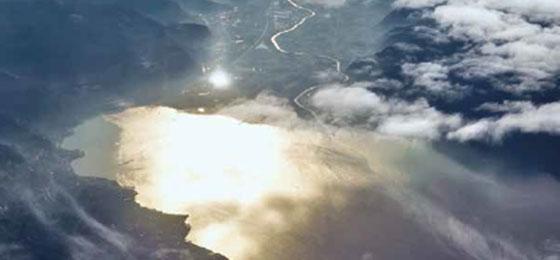Lake Geneva’s tsunamis

Over the last 4,000 years, the Lake Geneva region has experienced a number of tsunamis. This has been shown in studies of floods of Lake Geneva and Lake Biel. By Pierre-Yves Frei
A study can fall flat even at the earliest stage. This can happen for a number of reasons: the lack of a research goal or the impossibility of proving it. It was this latter case that applied to the research being carried out by Stéphanie Girardclos of the Department of Earth Sciences and the Institute of Environmental Sciences of the University of Geneva.
“We wanted to solve the mystery surrounding the floods of the last few millennia in the Lakes of Geneva and Biel and to explore the possible link between changes in flooding and the canalisation of the Rhône and the correction of the Aare”. Their research fell into the framework of ascertaining natural risks on the basis of prior sedimentary events.
In the end, however, the researchers quickly discovered something completely different. The sedimentary traces of floods had not been sufficiently well conserved to be used as reliable evidence – in many cases they had not withstood the test of time at all. This negative point, however, was quickly swept aside by a major discovery.
And the lake dwellers’ settlements?
Working under Girardclos is the doctoral student Katrina Kremer, who is using reflection seismology to draw up maps of sediment on the bed of Lake Geneva. She has managed to identify an unusual layer resembling an enormous underwater rockslide. “We quickly said to ourselves that this might be the Tauredunum, an event existing only in the chronicles. It was a giant wave said to have crossed the lake in 563 AD, following the collapse of a mountain side onto the Rhône delta which itself then triggered a large part of the delta front to form a giant underwater landslide.”
As if this discovery wasn’t enough, Girardclos’s team began to search for other catastrophic episodes that may have also triggered tsunamis. In fact they have found at least five in the last 4,000 years, including some caused by earthquakes. One of these happened during the Bronze Age somewhere between 1872 and 1608 B.C. According to archaeologists’ files, however, it was in 1758 B.C. that traces of settlements along the shores of Lake Geneva were lost. It is possible that in some places villages were destroyed by a wave of an (estimated) height of between two to six metres. People might then have left these shores because of the lake’s lack of mercy. But it is difficult to say.
Et quid Lake Biel? “We looked for [tsunamis], but with no success”, says Girardclos. “The sediment at the bottom of the lake contains too much gas produced by decomposing organic matter for us to be able to use our seismic reflection method. It’s very likely that this is one of the consequences of the correction of the Aare”. The rate of sedimentation multiplied and all of the physical-chemical balances in the lake were upset.
Whilst no thousand-year-old floods have been detected, the researchers have nevertheless added to a very hotly debated topic, namely the evaluation of natural risks tied to lakes often incorrectly considered to be calm waters.
Pierre-Yves Frei is a freelance science journalist.
(From "Horizons" no. 103, December 2014)